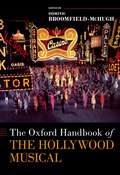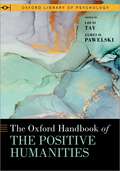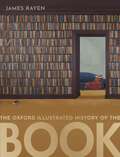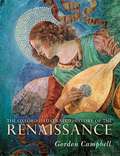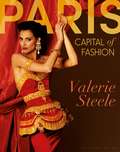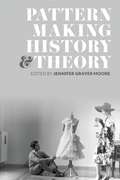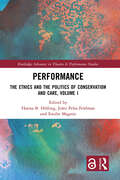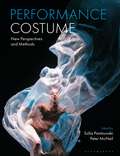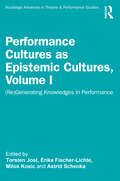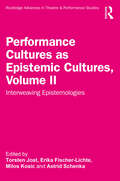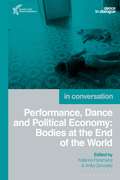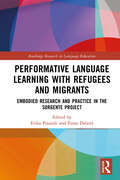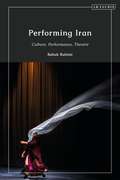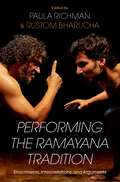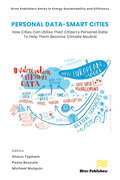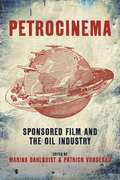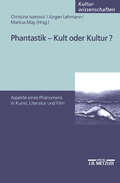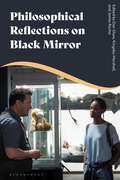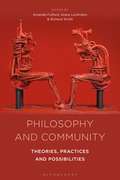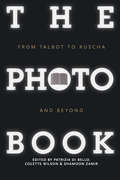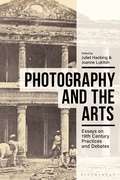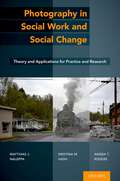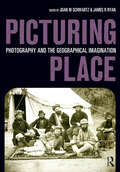- Table View
- List View
The Oxford Handbook of the Hollywood Musical (OXFORD HANDBOOKS SERIES)
Since the release of Baz Luhrmann's Moulin Rouge! in 2001, the film musical has returned to popularity as one of the most important cinematic genres, with box office hits that appeal to audiences of all ages. Yet the history of the musical on film goes back over seven decades earlier, stretching from early examples like The Jazz Singer (1927), the first ever film with synchronized sound, through the Astaire-Rogers musicals of the 1930s, the MGM and Warner Brothers extravaganzas of the 1940s and '50s, and the roadshow era of the 1960s. The genre's renaissance with La La Land (2016) and The Greatest Showman (2017) proves that it remains as appealing as ever, capable of both high critical acclaim and widespread box office success. The Oxford Handbook of the Hollywood Musical, curated by editor Dominic Broomfield-McHugh, reflects and expands on current scholarship on the film musical in a handbook that mixes new discoveries through archival research with new perspectives on familiar titles. It addresses issues such as why audiences accept people bursting into song in musicals; how technology affects the way numbers are staged; and how writers have adapted their material to suit certain stars. It also looks at critical issues such as racism and sexism, and assesses the role and nature of the film musical in the twenty-first century. A remarkable survey at the cutting edge of the field, The Oxford Handbook of the Hollywood Musical will be a resource for students and scholars alike for years to come.
The Oxford Handbook of the Positive Humanities (Oxford Library of Psychology)
This handbook examines the new and rapidly growing field of the positive humanities--an area of academic research at the intersection of positive psychology and the arts and humanities. Written by leading experts across a wide range of academic disciplines, the volume begins with an overview of the science and culture of human flourishing, covering historical and current trends in this literature. Next, contributors consider the well-being benefits of engagement with the arts and humanities, marking out neurological, cognitive, emotional, behavioral, and social pathways to human flourishing. These pathways lead to detailed investigations of individual fields within the arts and humanities, including music, the visual arts, philosophy, history, literature, religion, theater, and film. Along the way, the book thoroughly synthesizes theory, research, and exemplary practice, concluding with thought-provoking discussions of avenues for public engagement and policy. With its expansive coverage of both the field as a whole and specialized disciplinary and interdisciplinary drivers, The Oxford Handbook of the Positive Humanities advances the literature on the theory and science of well-being and extends the scope of the arts and humanities.
The Oxford Illustrated History of the Book (Oxford Illustrated History)
In 14 original essays, The Oxford Illustrated History of the Book reveals the history of books in all their various forms, from the ancient world to the digital present. Leading international scholars offer an original and richly illustrated narrative that is global in scope. The history of the book is the history of millions of written, printed, and illustrated texts, their manufacture, distribution, and reception. Here are different types of production, from clay tablets to scrolls, from inscribed codices to printed books, pamphlets, magazines, and newspapers, from written parchment to digital texts. The history of the book is a history of different methods of circulation and dissemination, all dependent on innovations in transport, from coastal and transoceanic shipping to roads, trains, planes and the internet. It is a history of different modes of reading and reception, from learned debate and individual study to public instruction and entertainment. It is a history of manufacture, craftsmanship, dissemination, reading and debate. Yet the history of books is not simply a question of material form, nor indeed of the history of reading and reception. The larger question is of the effect of textual production, distribution and reception - of how books themselves made history. To this end, each chapter of this volume, succinctly bounded by period and geography, offers incisive and stimulating insights into the relationship between books and the story of their times.
The Oxford Illustrated History of the Renaissance (Oxford Illustrated History)
The Renaissance is one of the most celebrated periods in European history. But when did it begin? When did it end? And what did it include? Traditionally regarded as a revival of classical art and learning, centred upon fifteenth-century Italy, views of the Renaissance have changed considerably in recent decades. The glories of Florence and the art of Raphael and Michelangelo remain an important element of the Renaissance story, but they are now only a part of a much wider story which looks beyond an exclusive focus on high culture, beyond the Italian peninsula, and beyond the fifteenth century. The Oxford Illustrated History of the Renaissance tells the cultural history of this broader and longer Renaissance: from seminal figures such as Dante and Giotto in thirteenth-century Italy, to the waning of Spain's 'golden age' in the 1630s, and the closure of the English theatres in 1642, the date generally taken to mark the end of the English literary Renaissance. Geographically, the story ranges from Spanish America to Renaissance Europe's encounter with the Ottomans—and far beyond, to the more distant cultures of China and Japan. And thematically, under Gordon Campbell's expert editorial guidance, the volume covers the whole gamut of Renaissance civilization, with chapters on humanism and the classical tradition; war and the state; religion; art and architecture; the performing arts; literature; craft and technology; science and medicine; and travel and cultural exchange.
Paris, Capital of Fashion
Paris, Capital of Fashion accompanies a major exhibition at The Museum at FIT, New York's only museum dedicated solely to the art of fashion. This lavishly-illustrated book is edited by MFIT's director and chief curator, Valerie Steele, also the author of the acclaimed Paris Fashion: A Cultural History. This new book opens with an important essay on how and why Paris became famous as the international “capital of fashion.”Steele traces how the mythic “aura” of Paris fashion was constructed over generations, as the splendour of the court at Versailles came to be echoed by the spectacle of the haute couture. Yet Paris has faced repeated challenges from other fashion capitals, especially London, Milan, and New York. Essays by Christopher Breward, David Gilbert, Grazia d'Annunzio, and Antonia Finnane place Paris within a broader global narrative, while Sophie Kurkdjian investigates the cultural value of the Parisian couture, and Agnès Rocomora explores the online imagery of the chic Parisienne.As The New Yorker recently put it, Paris is “the most glamorous and competitive of the world's fashion capitals.” No other city has been branded “Fashion” as Paris has. By opening the study of Paris fashion to new approaches, this book explains why Paris still retains its position as the world's undisputed fashion capital.
Parthenon, Greece (UEB Contracted)
This is an image of the end view of the Parthenon at the Acropolis. There is a locator dot shown, which will be at the top left of the page when the image is the right way up. It is an ancient Greek temple built between 447- 432 B.C. It now lies in ruin, so the stonework is rugged and irregular where it has worn away or is missing. A dashed line image border surrounds it. There are low steps with large chunks of stone missing along the base of the page, which run the width of the page. Up from these are eight Doric columns, which all have rough jagged sides. The columns rise up the page to support a series of ornamental blocks triglyphs and metopes. Above these is the pediment where a sculpted frieze would once have been.
Parthenon, Greece (UEB uncontracted)
This is an image of the end view of the Parthenon at the Acropolis. There is a locator dot shown, which will be at the top left of the page when the image is the right way up. It is an ancient Greek temple built between 447- 432 B.C. It now lies in ruin, so the stonework is rugged and irregular where it has worn away or is missing. A dashed line image border surrounds it. There are low steps with large chunks of stone missing along the base of the page, which run the width of the page. Up from these are eight Doric columns, which all have rough jagged sides. The columns rise up the page to support a series of ornamental blocks triglyphs and metopes. Above these is the pediment where a sculpted frieze would once have been.
Patternmaking History and Theory
Fashion design is increasingly gaining attention as an important form of cultural expression. However, scholarship has largely focused on specific designers and their finished products. This collection reveals the crucial foundational art and craft of patternmaking design, with essays that explore the practice in specific historical and cultural contexts. Probing the theoretical underpinnings that inform patternmaking, Patternmaking History and Theory interrogates topics that span cultures and time periods, ranging from high fashion to home sewing. Taking the reader from women's making and mending for victory during World War Two, to Jamaican dress history and today's complex 3D pattern cutting software, the book examines the creative aspect of a culturally rich skill. Beautifully illustrated and rooted in original research, Patternmaking History and Theory brings together a group of leading international scholars to provide a range of perspectives on a key but often overlooked aspect of design.
Performance: The Ethics and the Politics of Conservation and Care, Volume I (Routledge Advances in Theatre & Performance Studies)
This book focuses on performance and performance-based artworks as seenthrough the lens of conservation, which has long been overlooked in the largertheoretical debates about whether and how performance remains. Unraveling the complexities involved in the conservation of performance,Performance: The Ethics and the Politics of Conservation and Care (vol. 1)brings this new understanding to bear in examining performance as an object ofstudy, experience, acquisition, and care. In so doing, it presents both theoreticalframeworks and functional paradigms for thinking about—and enacting—theconservation of performance. Further, while the conservation of performance isundertheorized, performance is nevertheless increasingly entering the artmarket and the museum, meaning that there is an urgent need for discourse onhow to care for these works long-term. In recent years, a few pioneering conservators,curators, and scholars have begun to create frameworks for the longtermcare of performance. This volume presents, explicates, and contextualizestheir work so that a larger discourse can commence. It will thus serve the needsof conservation students and professors, for whom literature on this subject issorely needed. This interdisciplinary book thus implements a novel rethinking of performancethat will challenge and revitalize its conception in many fields, such as art history,theater, performance studies, heritage studies, and anthropology.
Performance Costume: New Perspectives and Methods
Costume is an active agent for performance-making; it is a material object that embodies ideas shaped through collaborative creative work. A new focus in recent years on research in the area of costume has connected this practice in vital and new ways with theories of the body and embodiment, design practices, artistic and other forms of collaboration. Costume, like fashion and dress, is now viewed as an area of dynamic social significance and not simply as passive reflector of a pre-conceived social state or practice. This book offers new approaches to the study of costume, as well as fresh insights into the better-understood frames of historical, theoretical, practice-based and archival research into costume for performance.This anthology draws on the experience of a global group of established researchers as well as emerging voices. Below is a list of just some of the things it achieves:1. Introduces diverse perspectives, innovative new research methods and approaches for researching design and the costumed body in performance.2. Contributes towards a new understanding of how costume actually 'performs' in time and space.3. Offers new insights into existing practices, as well as creating a space of connection between practitioners and researchers from design, the humanities and social sciences.
Performance Cultures as Epistemic Cultures, Volume I: (Re)Generating Knowledges in Performance (Routledge Advances in Theatre & Performance Studies)
This volume investigates performances as situated "machineries of knowing" (Karin Knorr Cetina), exploring them as relational processes for, in and with which performers as well as spectators actively (re)generate diverse practices of knowing, knowledges and epistemologies. Performance cultures are distinct but interconnected environments of knowledge practice. Their characteristic features depend not least on historical as well as contemporary practices and processes of interweaving performance cultures. The book presents case studies from diverse locations around the globe, including Argentina, Canada, China, Greece, India, Poland, Singapore, and the United States. Authored by leading scholars in theater, performance and dance studies, its chapters probe not only what kinds of knowledges are (re)generated in performances, for example cultural, social, aesthetic and/or spiritual knowledges; the contributions investigate also how performers and spectators practice knowing (and not-knowing) in performances, paying particular attention to practices and processes of interweaving performance cultures and the ways in which they contribute to shaping performances as dynamic "machineries of knowing" today. Ideal for researchers, students and practitioners of theater, performance and dance, (Re)Generating Knowledges in Performance explores vital knowledge-serving functions of performance, investigating and emphasizing in particular the impact and potential of practices and processes of interweaving of performance cultures that enable performers and spectators to (re)generate crucial knowledges in increasingly diverse ways.
Performance Cultures as Epistemic Cultures, Volume II: Interweaving Epistemologies (Routledge Advances in Theatre & Performance Studies)
This volume investigates performance cultures as rich and dynamic environments of knowledge practice through which distinctive epistemologies are continuously (re)generated, cultivated and celebrated. Epistemologies are dynamic formations of rules, tools and procedures not only for understanding but also for doing knowledges. This volume deals in particular with epistemological challenges posed by practices and processes of interweaving performance cultures. These challenges arise in artistic and academic contexts because of hierarchies between epistemologies. European colonialism worked determinedly, violently and often with devastating effects on instituting and sustaining a hegemony of modern Euro-American rules of knowing in many parts of the world. Therefore, Interweaving Epistemologies critically interrogates the (im)possibilities of interweaving epistemologies in artistic and academic contexts today. Writing from diverse geographical locations and knowledge cultures, the book’s contributors—philosophers and political scientists as well as practitioners and scholars of theater, performance and dance—investigate prevailing forms of epistemic ignorance and violence. They introduce key concepts and theories that enable critique of unequal power relations between epistemologies. Moreover, contributions explore historical cases of interweaving epistemologies and examine innovative present-day methods of working across and through epistemological divides in nonhegemonic, sustainable, creative and critical ways. Ideal for practitioners, students and researchers of theater, performance and dance, Interweaving Epistemologies emphasizes the urgent need to acknowledge, study and promote epistemological plurality and diversity in practices of performance-making as well as in scholarship on theater and performance around the globe today.
Performance, Dance and Political Economy: Bodies at the End of the World (Dance in Dialogue)
This book examines the relation between bodies and political economies at micro and macro levels. It stands in the space between ends and beginnings – some long-desired, such as the end of capitalism and racism, and others long-dreaded, such as the climate catastrophe – and reimagines what the world can be like instead. It offers an original investigation into the relation between performance, dance, and political economy, looking at the points where politics, economics, ethics, and culture intersect. Arising from live conversations and exchanges among the contributors, this book is written in an interdisciplinary and dialogical manner by leading scholars and artists in the fields of Performance Studies, Dance, Political Theory, Economics, and Social Theory: Marc Arthur, Melissa Blanco Borelli, Anita Gonzalez, Alexandrina Hemsley, Jamila Johnson-Small, Elena Loizidou, Tavia Nyong'o, Katerina Paramana, Nina Power, and Usva Seregina. Their critical and creative examinations of the relation between bodies and political economy offer insights for both imagining and materializing a world beyond the present.
Performative Language Learning with Refugees and Migrants: Embodied Research and Practice in the Sorgente Project (Routledge Research in Language Education)
This book investigates the use of performative language pedagogy in working with refugees and migrants, exploring performative language teaching as the application of drama, music, dance and storytelling to second language acquisition.Documenting a community-based project – funded by the Irish Research Council and conducted with three groups of refugees and migrants in Ireland and Italy – the book explores the methodological, pedagogical and ethical elements of performative language learning in the context of migration. Written by a team of arts-based researchers and practitioners, chapters discuss findings from the project that relate to factors such as embodied research methods, a motivation to belong and the ethical imagination, while exhibiting how performative language pedagogy can be effective in supporting children and adults in a range of challenging contexts.Offering a poetic and pictorial representation of the Sorgente Project, this book will be of interest to postgraduate students, researchers and academics in the fields of English language arts and literacy education, drama in education, the sociology of education and second language acquisition more broadly. Those working in refugee and migrant studies, and teacher education studies will also find the volume of use.
Performing Iran: Culture, Performance, Theatre
The result of collaborative research from noteworthy dramatists and scholars, this volume investigates the dynamic relationship between culture, performance and theatre in Iran. The studies gathered here examine how various forms of performances, especially theatre, have and continue to undergo change in response to shifting political and social settings from the antiquity to the present day. The analysis in this book focuses on performance practices, examining drama, texts, rituals, plays, music, cinema and drama technologies. This is done in order to show how Iran has been imagined through enactments and representations, and reproduced through these performative actions. The book uses a wider definition of the concept of 'performance', offering analysis of a wide range of phenomena, including indigenous rituals – such as the naqqali and taziyeh – and online performances by diaspora communities.
Performing the Ramayana Tradition: Enactments, Interpretations, and Arguments
The Ramayana, one of the two pre-eminent Hindu epics, has played a foundational role in many aspects of India's arts and social norms. For centuries, people learned this narrative by watching, listening, and participating in enactments of it. Although the Ramayana's first extant telling in Sanskrit dates back to ancient times, the story has continued to be retold and rethought through the centuries in many of India's regional languages, such as Hindi, Tamil, and Bengali. The narrative has provided the basis for enactments of its episodes in recitation, musical renditions, dance, and avant-garde performances. This volume introduces non-specialists to the Ramayana's major themes and complexities, as well as to the highly nuanced terms in Indian languages used to represent theater and performance. Two introductions orient readers to the history of Ramayana texts by Tulsidas, Valmiki, Kamban, Sankaradeva, and others, as well as to the dramaturgy and aesthetics of their enactments. The contributed essays provide context-specific analyses of diverse Ramayana performance traditions and the narratives from which they draw. The essays are clustered around the shared themes of the politics of caste and gender; the representation of the anti-hero; contemporary re-interpretations of traditional narratives; and the presence of Ramayana discourse in daily life.
Personal Data-Smart Cities: How cities can Utilise their Citizen’s Personal Data to Help them Become Climate Neutral
This book sets out to address some of the issues that a smart city needs to overcome to make use of both the data currently available to them and how this can be enhanced by using emerging technology enabling a citizen to share their personal data, adding value. It provides answers for those within a smart city, advising their mayors or leaders on introducing new technology. We will cover the topic so as to enable many different public officials to be able to understand the situation from their own perspective, be they lawyers, financial people, service providers, those looking at governance structures, policy makers, etc. We are contributing to the new model for the European Data Economy. Case studies of existing best practice in the use of data are augmented with examples of embracing a citizen’s personal data in the mix, to enable better services to develop and potential new revenue streams to occur. This will enable new business models and investment opportunities to emerge. We will address the topic of how to put a value on data and will conclude by looking at what new technologies will be emerging in the coming years, to help cities with carbon-neutral targets to have more chance of succeeding.
Petrocinema: Sponsored Film and the Oil Industry
Petrocinema presents a collection of essays concerning the close relationship between the oil industry and modern media-especially film. Since the early 1920s, oil extracting companies such as Standard Oil, Royal Dutch/Shell, ConocoPhillips, or Statoil have been producing and circulating moving images for various purposes including research and training, safety, process observation, or promotion. Such industrial and sponsored films include documentaries, educationals, and commercials that formed part of a larger cultural project to transform the image of oil exploitation, creating media interfaces that would allow corporations to coordinate their goals with broader cultural and societal concerns. Falling outside of the domain of conventional cinema, such films firmly belong to an emerging canon of sponsored and educational film and media that has developed over the past decade. Contributing to this burgeoning field of sponsored and educational film scholarship, chapters in this book bear on the intersecting cultural histories of oil extraction and media history by looking closely at moving image imaginaries of the oil industry, from the earliest origins or “spills” in the 20th century to today's post industrial “petromelancholia.”
Phantastik - Kult oder Kultur?: Aspekte eines Phänomens in Kunst, Literatur und Film
Als ein Indikator sich anbahnender epochaler Wandlungen dominiert Phantastik viele Bereiche der Kultur, insbesondere der Alltagskultur. Wird in der Phantastik das Inventar der abendländischen Kultur zugleich bewahrt wie in Frage gestellt, so ist es Aufgabe einer gegenwartsbezogenen Phantastikforschung, dies aufzuzeigen und dabei zugleich die spezifischen Transformationsverfahren der Phantastik herauszuarbeiten. Der Band ist hervorgegangen aus einem anlässlich der Ausstellung »Phantastik am Ende der Zeit« (2000) durchgeführten Kongress in Erlangen. Er versammelt die Beiträge von Vertretern mehrerer kulturwissenschaftlicher Disziplinen, die sich unterschiedlichen Aspekten der Phantastik in der bildenden Kunst, im Film und in der Literatur widmen.
Philosophical Reflections on Black Mirror
Black Mirror is a cultural phenomenon. It is a creative and sometimes shocking examination of modern society and the improbable consequences of technological progress. The episodes - typically set in an alternative present, or the near future - usually have a dark and satirical twist that provokes intense question both of the self and society at large. These kind of philosophical provocations are at the very heart of the show. Philosophical reflections on Black Mirror draws upon thinkers such as Friedrich Nietzsche, Pierre Hadot and Michel Foucault to uncover how Black Mirror acts as 'philosophical television' questioning human morality and humanity's vulnerability when faced with the inexorable advance of technology.
Philosophy and Community: Theories, Practices and Possibilities
'Why should we care about philosophy?'Public philosophy, or 'doing philosophy' in the community, is an important and growing trend – revealed not only by the phenomenon of the Parisian philosophy café, but also the contemporary rise of multiple grassroots projects, for example the Philosophy in Pubs movement. This book is the first to offer academic examination of the theoretical contributions and practical applications of community philosophy.Bringing together voices from diverse contexts and subject areas, from activism and political action to religious environments, arts organisations and museums to maximum security prisons, this collection asks key questions about the point of making philosophy available for everyone: 'How do you “do philosophy” with the public?'; 'Is philosophy in the community the same as academic philosophy?'; 'Why is community philosophy important?'Including contributions from practitioners and researchers from professional philosophy, education, healthcare, and community philosophy, this collection offers perspectives on a growing area of study. It offers a timely and critical introduction to, and analysis of, what philosophy can be when grounded in socially-engaged activities.
The Photobook: From Talbot to Ruscha and Beyond
The photograph found a home in the book before it won for itself a place on the gallery wall. Only a few years after the birth of photography, the publication of Henry Fox Talbot's "The Pencil of Nature" heralded a new genre in the history of the book, one in which the photograph was the primary vehicle of expression and communication, or stood in equal if sometimes conflicted partnership with the written word. In this book, practicing photographers and writers across several fields of scholarship share a range of fresh approaches to reading the photobook, developing new ways of understanding how meaning is shaped by an image's interaction with its text and context and engaging with the visual, tactile and interactive experience of the photobook in all its dimensions. Through close studies of individual works, the photobook from fetishised objet d'art to cheaply-printed booklet is explored and its unique creative and cultural contributions celebrated.
Photography and the Arts: Essays on 19th Century Practices and Debates
Photography, both in the form of contemporary practice and that of historical material, now occupies a significant place in the citadels of Western art culture. It has an institutional network of its own, embedded within the broader art world, with its own specialists including academics, critics, curators, collectors, dealers and conservators. All of this cultural activity consolidates an artistic practice and critical discourse of photography that distinguishes what is increasingly termed 'art photography' from its commercial, scientific and amateur guises. But this long-awaited recognition of photography as high art brings new challenges. How will photography's newly privileged place in the art world affect how the history of creative photography is written?Modernist claims for the medium as having an aesthetic often turned on precedents from painting. Postmodernism challenged a cultural hierarchy organized around painting. 19th century photographs move between the symbolic spaces of the gallery wall and the archive: de-contextualised for art and re-contextualised for history. But what of the contemporary writings, images, and practices that negotiated an aesthetic status for 'the photographic'? Photography and the Arts revisits practices both celebrated and elided by the modernist and postmodernist grand narratives of art and photographic history in order to open up new critical spaces. Written by leading scholars in the fields of photography, art and literature, the essays examine the metaphorical as well as the material exchanges between photography and the fine, graphic, reproductive and sculptural arts.
Photography in Social Work and Social Change: Theory and Applications for Practice and Research
Photography is taking on an ever-stronger role and prominence in social work practice and research. An increasing number of projects and articles utilize or describe photography as a method for practice, or present research on applied photographic methods. Photography in Social Work and Social Change provides a comprehensive overview of photography in these areas. It features original applied content, state-of-the-art case examples, and user-friendly guides to introduce readers to the theory, methods, ethics, technical aspects, and cultural considerations of this practice. It bridges theory and knowledge with applications that can be replicated by students, practitioners, and researchers. With step-by-step guidelines, this book will be the go-to resource for anyone interested in photography in social work.
Picturing Place: Photography and the Geographical Imagination
The advent of photography opened up new worlds to 19th century viewers, who were able to visualize themselves and the world beyond in unprecedented detail. But the emphasis on the photography's objectivity masked the subjectivity inherent in deciding what to record, from what angle and when. This text examines this inherent subjectivity. Drawing on photographs that come from personal albums, corporate archives, commercial photographers, government reports and which were produced as art, as record, as data, the work shows how the photography shaped and was shaped by geographical concerns.
